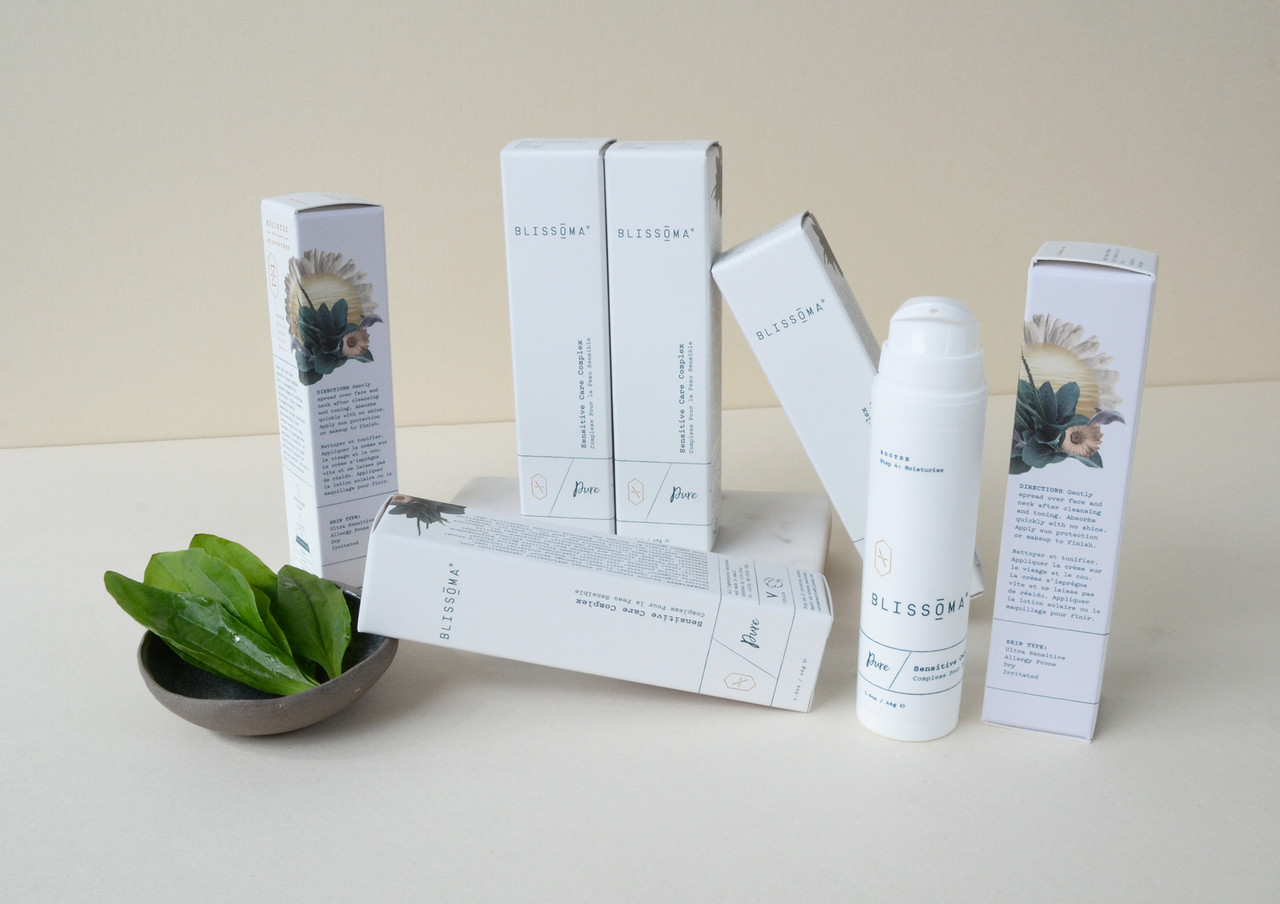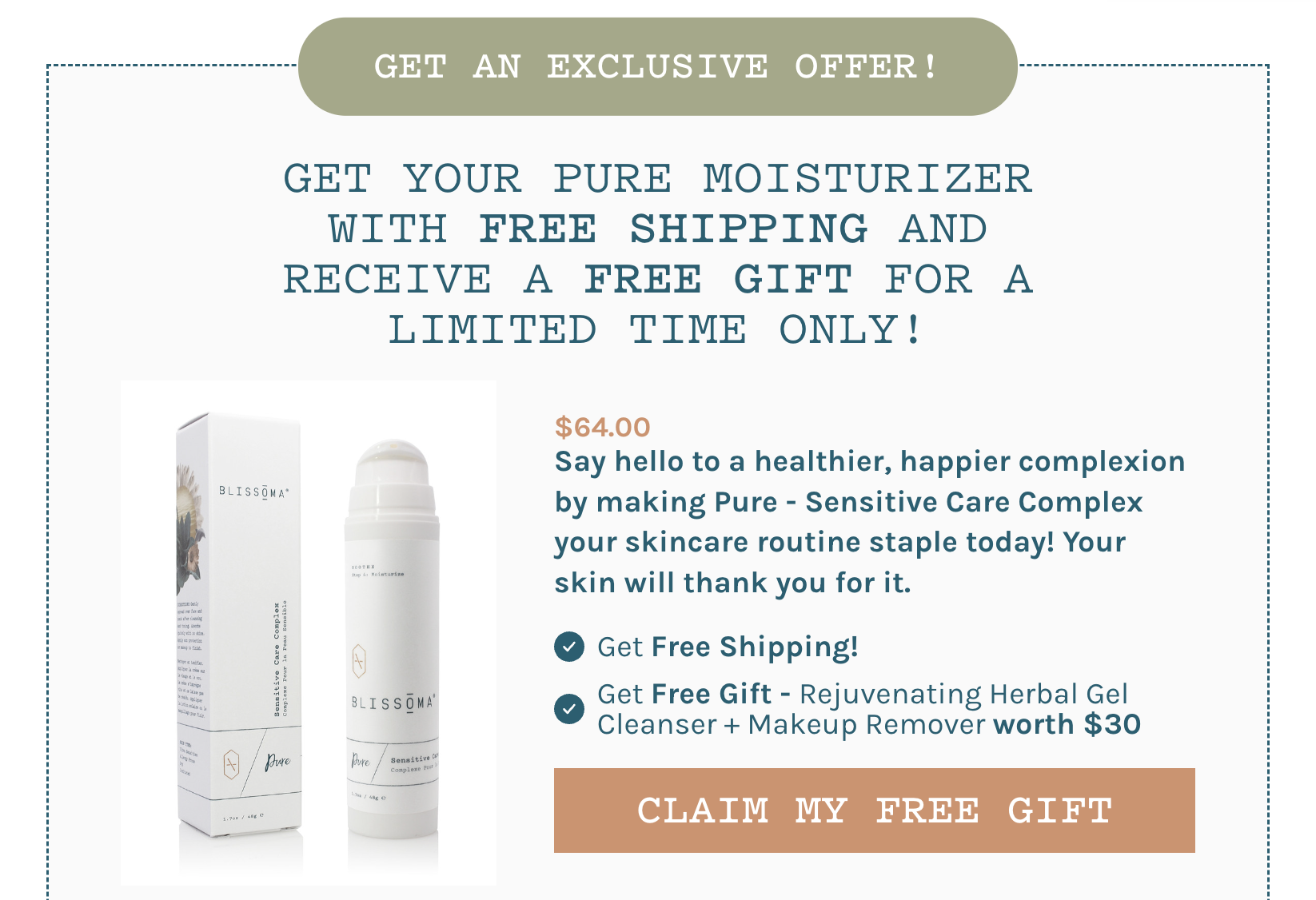There is a fairly constant clash between natural/organic skincare and synthetic skincare over whose ingredients and formulations are safe and effective. One of the biggest things that leads people to more synthetic skincare choices is the idea that they want a product that “really works”. In 15 years we’ve seen even the most devoted organic juicing yoga teachers feel the lure of “results” shown in drastic before/after photos and consider how flexible their values are when it comes to synthetics and aggressive ingredients in skincare.
The green beauty industry started small with independent founders and plant-based formulas. This is both a strength and a weakness because many brands have great ingredients and recipes, but lack the funding of big corporate brands. 15 years ago the biggest selling point for natural skincare was fears around toxins - particularly endocrine disruptors - that could lead to long term health problems. Efficacy wasn’t the primary focus of conversation. Safety reigned supreme as the primary concern.
Even now the statistics tell us that 40% of consumers believe that natural and organic personal care is healthier, and about 22% of women purchase organic skincare for themselves for this type of reason. But healthy doesn't necessarily speak about efficacy, and we believe there is still a gap in understanding that needs to be filled.
Natural can be extremely effective when a product is well designed, just like any conventional, synthetic skincare product.
While Blissoma has always been a strictly natural and plant based brand, our first and foremost driving force is and actually has always been efficacy. I began making skincare because I had cystic acne and very sensitive skin, and I wanted to be done with skin problems for good. I wasn’t going to stop at anything less than having clear, healthy skin for life, and I want that for my customers. All our recipes are driven by this core concept. They are also natural, and the whole plant ingredients happen to be why they work.

Real people have always been our best source of feedback and every recipe has been developed with extensive contributions from friends, family, employees, and clients. The recipes have been tested extensively in real life situations. We get photos and emails from clients telling us how much their skin has changed, and for years that was all we needed to know that this crazy small business journey was completely worth it.
We also love science, though, and as a brand with a 15 year history we knew it was time to invest in hard, objective proof of our product efficacy. We work with dermatologists, estheticians, and people with serious skin needs. It’s important to us to know for sure what we offer.
We also know you deserve to know what you’re investing in. Our customers are often making skincare a priority in their budget and the cost has to be justified. Making skincare the way we do has more operational, ingredient, and formulation expenses tied to it than many brands. That’s only worth it if the product delivers.
That is why I am thrilled to share with you that this year Blissoma has conducted our first Clinical Test and has fantastic results to share with you.
What Does Clinically Tested or Clinically Proven Mean?
Clinical testing uses scientific methods to demonstrate product efficacy. Tests are generally conducted by third party, professional laboratories to increase impartiality and trustworthiness of the results.
Clinical tests for skincare generally involve volunteers who use the product in a predetermined way. Measurements are taken at the start, and at defined time points during the study, and at completion to determine changes that occur in the skin. If a skincare product wants to prove efficacy a clinical test is one of the best ways to do it. Instead of just someone’s friend of a friend saying they feel like the product improved their skin a clinical study defines efficacy in terms of measurable, objective changes to the skin.

Clinical testing just involves conducting a test. To be able to say clinically proven the product must generate results that are statistically significant to prove efficacy. Theoretically a brand could say their product is clinically tested, but the results of their test might not have shown significant efficacy. A test is how you measure, and the results that show efficacy are the proof.
Instrument and Expert-Graded Clinical Tests
There are many different types of study goals and many different types of measurements that can be taken. Instrumental and expert-graded studies are considered the most objective and unbiased type of testing.
Sometimes laboratory instruments are used to generate data about the skin. Here are some of the instruments used and what they measure:
- Tewameter® - measures transepidermal water loss
- Moisture Meter SC or Corneometer® - measures amount of moisture in the skin
- Sebumeter® - measures the amount of sebum produced and can be used for comedogenicity measurements
- Corneofix® - measures desquamation of skin (rate at which skin cells are sloughed)
- Elastimeter - measures elasticity of the skin
- Visioface® - facial photography system with even lighting that can also be used to analyze skin changes
Sometimes changes are evaluated and graded by professional lab personnel who are trained to notice changes in the skin. This person is known as a clinical grader.
Consumer Use Clinical Tests (also known as Consumer Use Surveys)
Some studies just have people use the product and give their opinions afterward. That type of study is called a consumer perception study, and is more like a survey than science. It can still be really useful to help show how happy people were with product performance, though, and that does really matter.
Age, ethnicity, and other factors can become important when selecting people for a consumer survey. Brands are under no obligation to report details about the survey group, but it's helpful when they do because you can see if they reflect your needs. A 20 year old and a 60 year old likely have very different skin needs and preferences, and the study participant may or may not have your skin conditions.
In conducting our clinical test we learned that people with sensitive skin tend to be very harsh about judging products in surveys because their skin is so prone to reaction.
That makes it unlikely that any survey group focusing on sensitive skin people will result in a 100% satisfaction level with almost any quality of the product.
Some companies with enough employees may even conduct consumer surveys on their own employee base, which could enhance the responses since employees are likely to feel invested in the outcome. This is one way that the survey group selection can drastically affect the data generated. It's good to be aware of the potential for bias when interpreting consumer use survey claims.
Why Would a Brand Do a Clinical Test on Their Skincare?
Clinical testing is not required to sell cosmetic products in the USA, and is not necessarily required in many other markets in the world to simply put a product up for sale. However, many countries do require clinical testing if a brand wants to make specific efficacy claims. In the USA clinical testing goes a step beyond what is required for safety and marketing purposes.
Blissoma has recently started selling products in the EU and has sold products into other world markets like South Korea, Taiwan, and Thailand in the past. In international markets where clinical testing is required for claims it gets much harder to communicate why people would want to try our recipes if efficacy data is not available. We effectively become barred from speaking about our real-world results because they are considered anecdotal rather than objective.
Clinical testing gives a brand actual statistics to share in marketing claims, and it gives consumers more assurance that they are spending their money wisely on a product that will give them the results they need.
True Botanicals was one of the first green beauty brands to really get into commissioning clinical tests of their products. In May of 2017 they took a seed round of investor funding and used a chunk of that to arrange clinical tests to prove their product performance against examples of popular luxury skincare. While this did a lot for them individually to help generate business it did also help fight the mistaken perception that natural isn’t effective.
As a completely independent, grassroots skincare brand Blissoma did not have venture capital to fund a study. Instead all our advancements and investments come from our existing sales base. We saved up and commissioned our own study in January of 2024. Today we are delighted to share the fantastic results with you.
Blissoma’s First Skincare Clinical Test: Naturally Reducing Skin Redness and Improving Skin Barrier Function With Our Pure Facial Cream
For years we have heard from our customers that Pure Sensitive Care Complex has immensely positive impacts on their skin redness. This product is mild but highly active due to our whole plant extracts and oils. From oncology patients to people with irritated, dry skin Pure serves a huge range of skin needs, and its popularity with our client base said it deserved to be the focus of our first clinical test.
About Blissoma's Participants for the Clinical Test of Pure Sensitive Care Complex
- 21 participants
- Men and women (2 men, 19 women)
- A variety of skin colors from Fitzpatrick I to IV (corresponds to level of melanin in skin)
- Mix of ethnicities including Hispanic, Berber, and Caucasian
- Ages 35- 62 with an average group age of 45.2
- The group included people with redness, sensitive skin, and normal skin (neither redness or sensitivity)
We conducted this clinical trial in the month of January in Canada, which is one of the most challenging times for both redness and skin sensitivity due to the extremely cold, dry air, wind, and changes in temperature that people experience when going in and outside.
We chose to evaluate the product in two key ways.
Clinical Test 1: Measuring Skin Barrier Improvements
An initial measurement was taken at the test skin site to determine the study participant’s baseline Transepidermal Water Loss (TEWL) rate using a Tewameter®. Pure Sensitive Care Complex facial cream was applied to the skin and the participants then measurements were taken again to determine changes, if any.
The Process to Measure Transepidermal Water Loss
- Participants relax in a climate controlled room prior to starting the test
- T0 (start of test) - Measurement is taken on untreated skin
- Product is applied to a specific area of skin
- Participants wait 1 hour
- T1 (1 hour after application) - Measurement is taken on both treated and untreated skin
- T8 (8 hours after application) - Measurement is taken again on both treated and untreated skin
The product was applied just once to the skin at the 0 hour mark, and an untreated area of skin was used as a negative control.
(A negative control is an example of what would happen if nothing was done to the skin, and it ensures that the instrument is not malfunctioning, and that the data created from the test skin site is real.)
Clinical Test 2: Determining if our Natural Facial Cream Can Reduce Redness over 4 Weeks
For the clinical test to judge effects on skin redness participants were given our Free Rejuvenating Herbal Gel Cleanser and Pure Sensitive Care Complex and were instructed to use only these two products on their skin as a morning and evening routine. They took the products home and used the products for 28 days (4 weeks) and then returned to the laboratory for final grading to see if there was any improvement to the redness levels of their facial skin.
The Process to Measure Facial Skin Redness
- Participants relax in a climate controlled room prior to starting the test
- T0 (start of test) - Photos are taken of the skin before treatment
- Clinical graders determine redness level at start and then record this number
- Participants take skincare products home and use them morning and evening
- T28 (28 days of product use) - Participants return to the lab and photos are taken again
- Clinical graders determine redness level for day 28 and record this number
Redness levels in tests like this are commonly given a grade of 0 (no redness) to 3 (severe redness).
Our participants started at 0 - 2 depending on if they were selected for their skin redness or if they were part of the sensitive skin group in the test. Some participants had both sensitivity and redness.
Blissoma’s Pure Sensitive Care Complex Strengthens the Skin Barrier and is Now a Clinically Proven Redness Reduction Cream
The clinical test of Pure Sensitive Care Complex was able to demonstrate that our natural facial cream is effective at strengthening the skin barrier with even just one use, and is also effective at substantially reducing skin redness when used over 4 weeks.
Skin Barrier Strengthening Results for our Natural Facial Cream
At 1 hour after use the skin site where Pure Sensitive Care Complex was applied had an average of 13.5% less Transepidermal Water Loss (TEWL) than the control skin site where no product was use. This means that the skin barrier was substantially stronger, and more hydration is being retained within the skin.
At 8 hours after a single use the group of study volunteers showed an average reduction of TEWL of 16.8%, so the results of our natural facial cream at creating a stronger skin barrier actually improved overall with time.

90% of study participants had improved skin barrier function 1 hour after using Pure Sensitive Care Complex.
If we consider just our sensitive skin participants 100% of the sensitive skin participants had improved skin barrier function at the 1 hour timepoint.
76% of overall study participants then had improved skin barrier function 8 hours after using Pure Sensitive Care Complex.
This shows the power of whole plant ingredients to benefit skin immediately and over time.
These results are considered statistically significant, and we can accurately claim that our natural facial cream substantially improves the skin barrier and reduces water loss through the skin.
Redness Reduction Results for our Natural Facial Cream
After 4 weeks of using a skincare routine of just Free Rejuvenating Herbal Gel Cleanser and then Pure Sensitive Care Complex our study participants showed redness reduction of 54% overall.
At the start of the clinical test the group scored an average rating of 1.1 out of 3 for skin redness. The maximum score for any participant was a grade of 2 at the start.
At the end of 4 weeks of using Blissoma’s two skincare products daily the group’s average redness score was just .5. No participants had a grade of 2 at the end. All participants were graded 0 or 1.
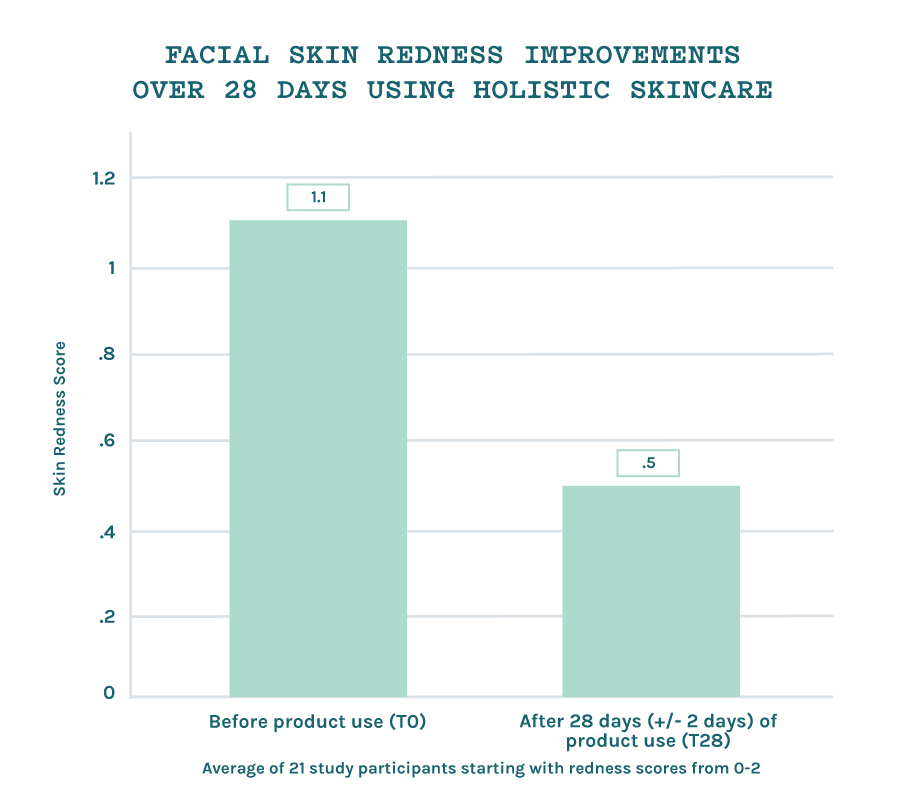
This is a substantial result, especially when the dry, irritating weather conditions of winter are taken into account.
No subjects experienced worsened redness in our study, which is notable because in a National Rosacea Society survey of 1066 patients, 41% reported that some skincare products aggravated their condition.
3 study participants had no initial redness, so could not show a decrease. If we remove these 3 people from our count then 66.7% of our participants with redness were able to achieve reduced redness by using a Blissoma skincare routine.
44% of our Pure clinical test participants that started with redness had total disappearance of their redness.
Before and After Images of Blissoma Clinical Study Participants
The lab took before and after images of our study participants using a Visio Face® 1000D to ensure the same lighting conditions for each photo. Below are several of the image sets that demonstrate improvement to facial redness.
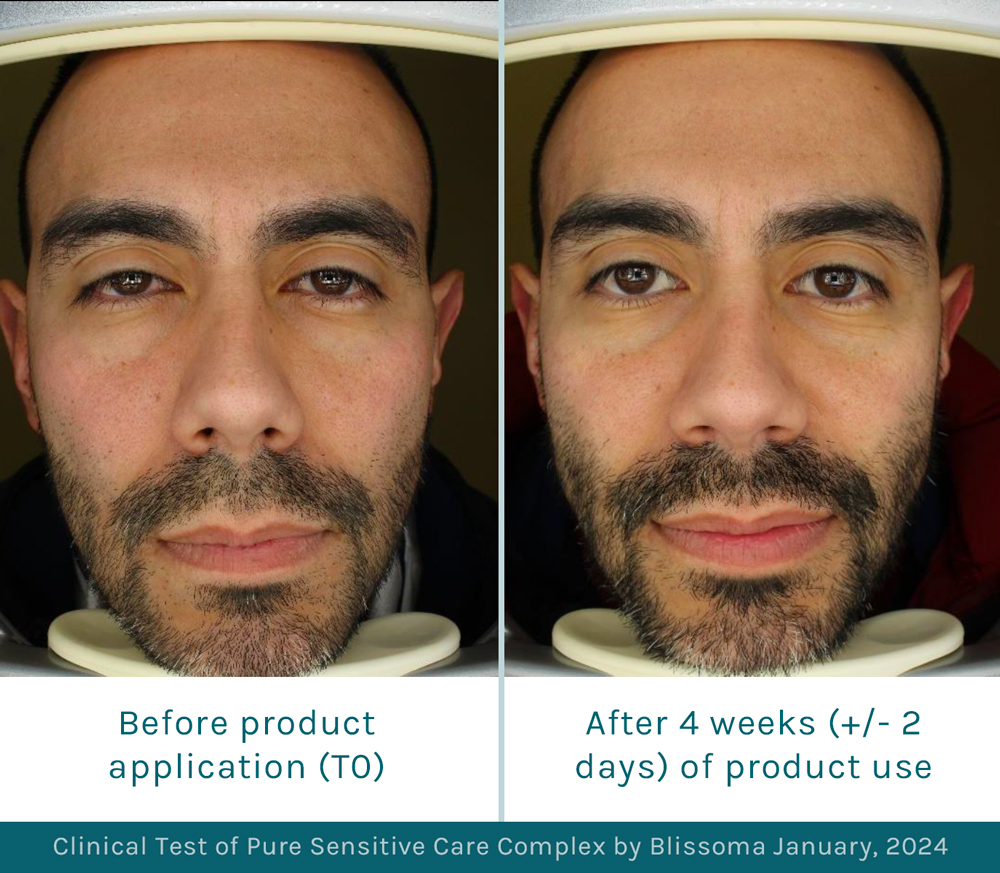
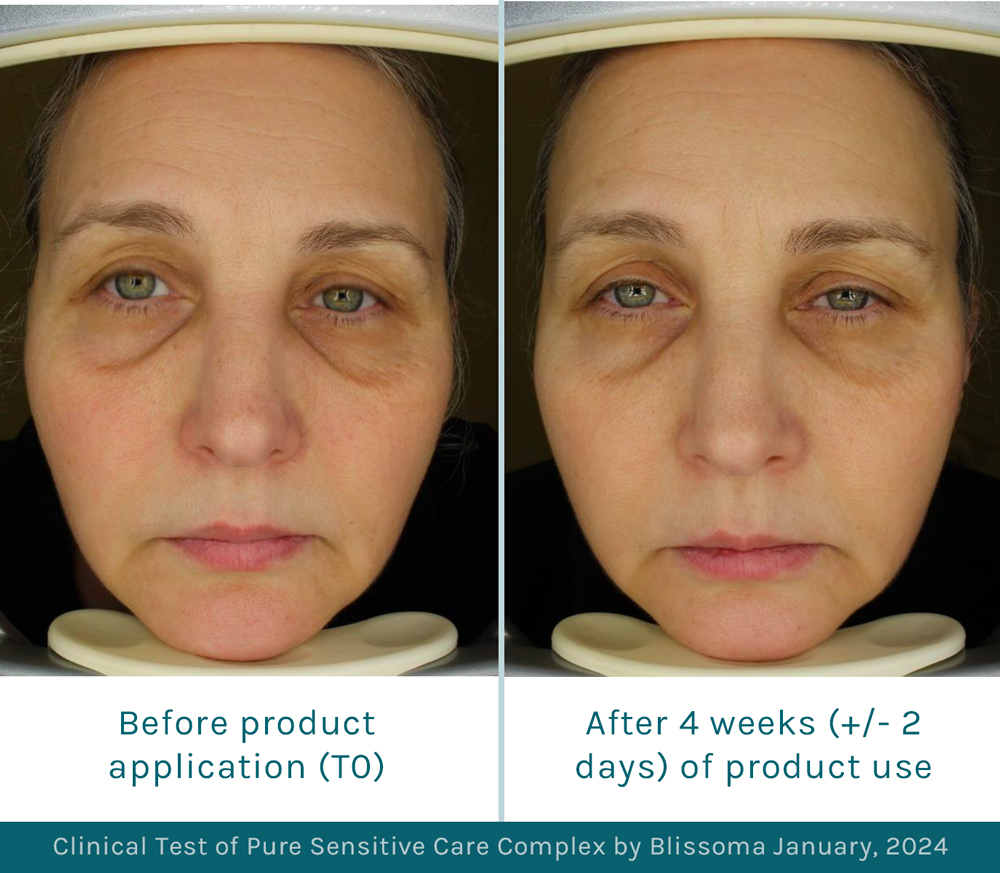
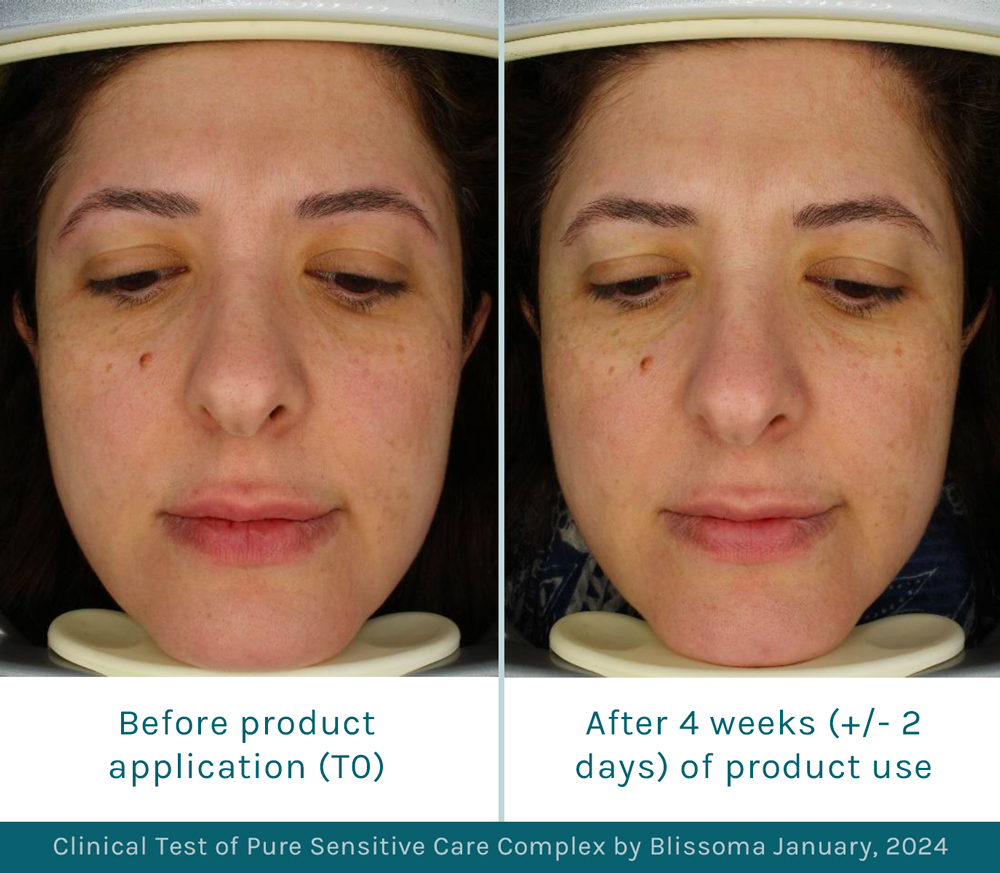
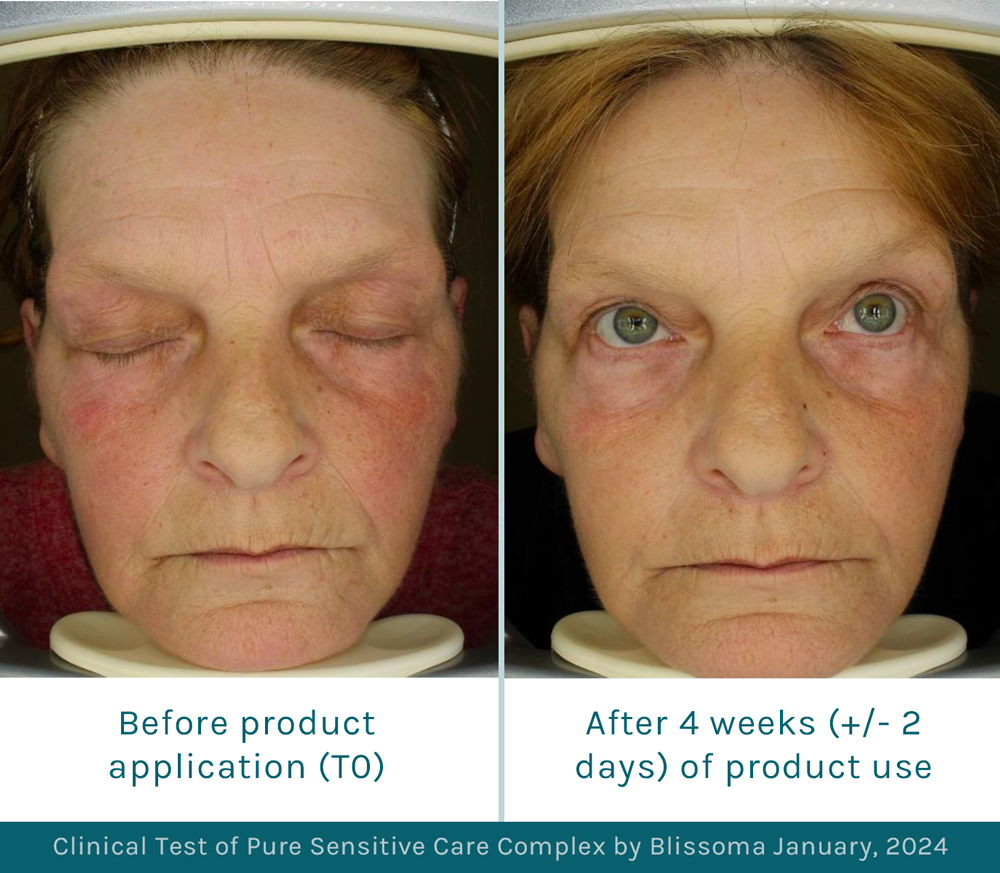
How Do the Clinical Test Results for Pure Sensitive Care Complex Compare to Tests of Other Popular Skincare Brands?
We were able to find published studies on several other skincare brands including products from Cetaphil, Vichy, La Roche Posay, Physiogel, and several unnamed skincare products from Iran.
Comparing TEWL Skin Barrier Clinical Test Results
Blissoma performed exceptionally well when compared with semi-natural and synthetic products.
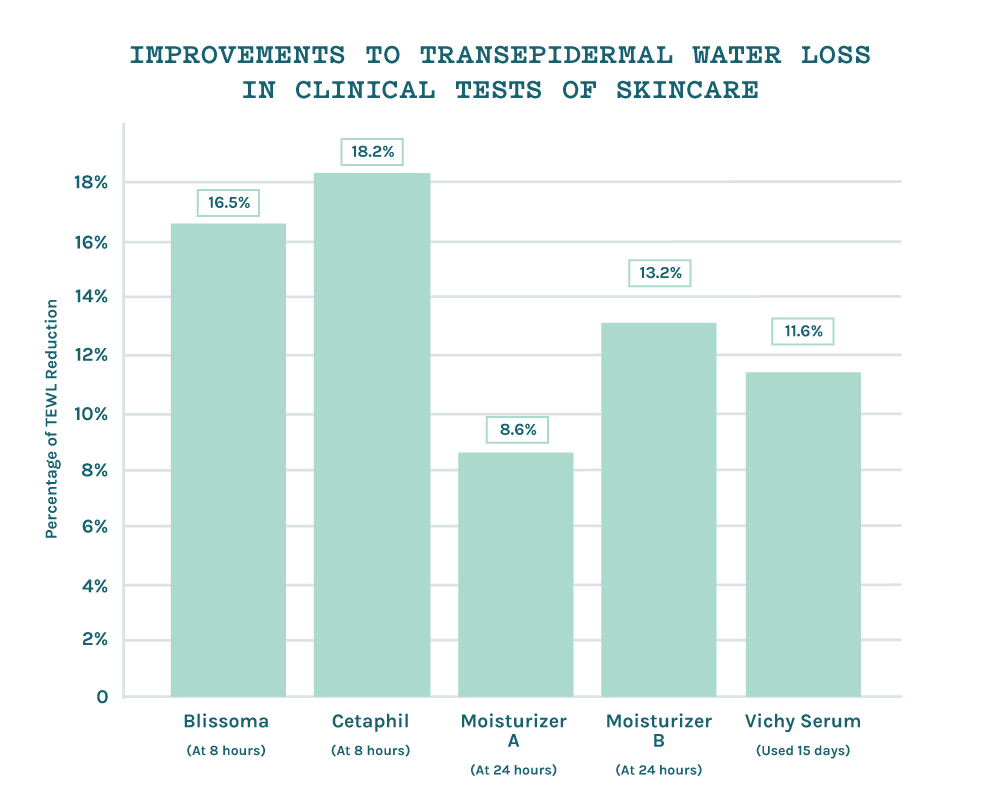
A study was conducted on two different Iranian moisturizing products in 2020. This particular study measured more aspects of skin barrier function than our test, but included in the range of tests was a measurement taken by Tewameter to judge TEWL at different time points. Their moisturizing products were applied once to skin just like in our test and they took measurements at 1, 4, and 24 hours. Their products included some naturally based ingredients and some synthetic ingredients like propylene glycol, pentylene glycol, carbomer, and dimethicone.
- Moisturizer A - 1 hour results = 8.4% less TEWL, 24 hour results = 8.6% less TEWL
- Moisturizer B - 1 hour results = 13.36% less TEWL, 24 hour results = 13.2% less TEWL
Graph of Iranian moisturizer study results
The 4 hour timepoint for both products in this test showed substantially higher TEWL.
Pure Sensitive Care Complex performed better than both of these products at the 1 hour timepoint, and at 8 hours also performed better than the 24 hour results of these moisturizers.
Vichy published a clinical test of their Mineral 89 Hyaluronic Acid Serum in 2023 showing that their product was able to reduce TEWL by 11.6% at 15 days of use and 11.1% after 30 days of use. This is a different time period than our barrier strength study, but still offers some comparison. Hyaluronic acid is often considered a moisturizing superpower ingredient, and this product has won multiple beauty awards, is dermatologist recommended, and has thousands of reviews. Pure Sensitive Care Complex outperformed the barrier enhancement properties of Vichy Mineral 89 Hyaluronic Acid Serum.
Redness was also included in this study, and Blissoma drastically outperformed the Vichy serum for efficacy against redness.
A study was also conducted on Cetaphil Redness Control Night Cream in 2018 that included both TEWL and redness measurements.
In that study the Cetaphil product was able to reduce TEWL significantly for the study group and measurements were taken at the 2 hour, 4 hour, and 8 hour mark. Measurements were again taken with a Tewameter.
Cetaphil Redness Control Night Cream results for TEWL reduction:
- 2 hour TEWL reduction of 18.0%
- 4 hour TEWL reduction of 14.3%
- 8 hour TEWL reduction of 18.2%
In this study the Cetaphil product outperformed Pure Sensitive Care Complex by 1.4% in the TEWL portion of the study, but this clearly demonstrates that our natural ingredients are keeping pace with synthetics for hydration retention.
The real difference in this study comes in the redness portion, where Pure significantly outperformed the Cetaphil product.
Comparing Redness Reduction Clinical Test Results
We scoured the internet to find studies that used comparable groups of people, clinical grading as a measurement, ran a test at a similar time of the year, and used the skincare product for a similar length of time.
We were able to find studies from 4 other skincare brands on their redness reduction results.
Out of these studies Blissoma's holistic skincare routine using Free Rejuvenating Herbal Gel Cleanser and Pure Sensitive Care Complex in the morning and evening created the best results by far.
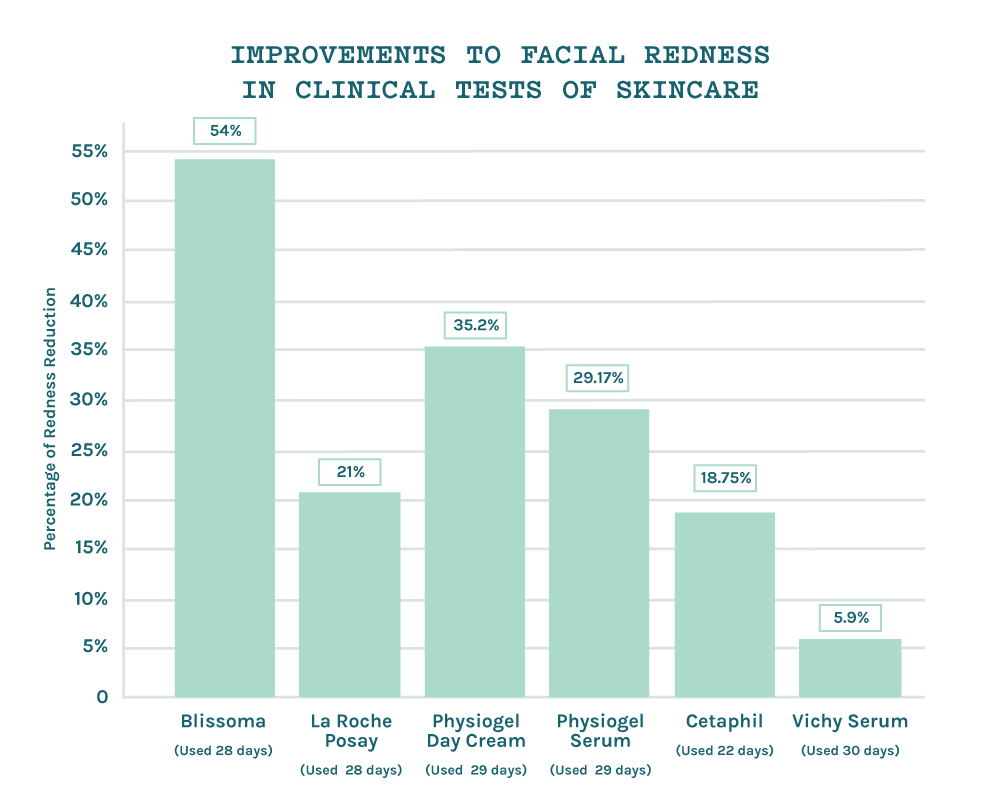
Comparing Holistic Redness Reduction Clinical Test Results with Cetaphil
Cetaphil Redness Control Night Cream has “redness control” in its name, so managing redness is clearly a major focus for this mass market product.
A clinical grader was also employed to judge redness scores in the 2018 Cetaphil study.
At the start of the test prior to product application the group was given an average score of 1.6 with all study participants falling into the 1 or 2 grade range. This is very similar to our study as the average score for our participants was 1.5 and none of our participants scored higher than a 2.
30 minutes after applying Cetaphil Redness Control Night Cream the group score actually increased because the rating had increased to 3 for some participants, a severe redness rating.
After 22 days of using the Cetaphil product the group’s overall clinically graded score was 1.3 with some participants remaining in the severe redness category.
Overall the Cetaphil product reduced the overall study group redness score by 18.75%.
Pure Sensitive Care Complex did not generate severe redness for any study participants, and was able to reduce the study group’s redness by 54%, almost 3x better than the Cetaphil product.
Comparing Pure Sensitive Care Complex Redness Reduction Results with La Roche Posay Skincare
Visit any social media discussion group for rosacea and you are likely to see recommendations for La Roche Posay. This brand has done a very effective job at defining themselves as a prime choice for people with facial skin redness, but is it the absolute best redness reduction skincare you can get?
Two published studies from their company provided great data for us to compare with the clinical test for Pure Sensitive Care Complex.
In August 2013 La Roche Posay published a study in the Journal of Drugs and Dermatology on the use of one of their formulas for the management of rosacea-prone skin. They tested the product by itself, in side-by-side use with drug treatment, and then thirdly as a maintenance routine after discontinuance of drug treatment.
The portion of the study that used their product alone was the most comparable to the study of Blissoma’s Pure facial cream.
La Roche Posay’s formula was able to decrease redness by 21% after 4 weeks of use. Blissoma's Pure Sensitive Care Complex performed over 2x better than the La Roche Posay product.
Another La Roche Posay study published in 2017 in the Journal of the American Academy of Dermatology examined the use of their skincare product on people with sensitive skin. The participants in this study also had some redness as a symptom of their sensitivity.
After 1 month of treatment with the La Roche Posay product, a significant decrease of skin redness occurred for more than half of the participants, with a total disappearance of redness for 43% of study participants.
In the study of Pure facial cream for sensitive skin 12 of our subjects out of 21 overall total participants showed reduced redness at Day 28, which is 57% of participants. 3 participants had no initial redness, so could not show a decrease. If we remove these 3 people then 66.7% of our participants with redness were able to achieve reduced redness by using a Blissoma skincare routine.
44% of our Pure clinical test participants that started with redness had total disappearance of their redness.
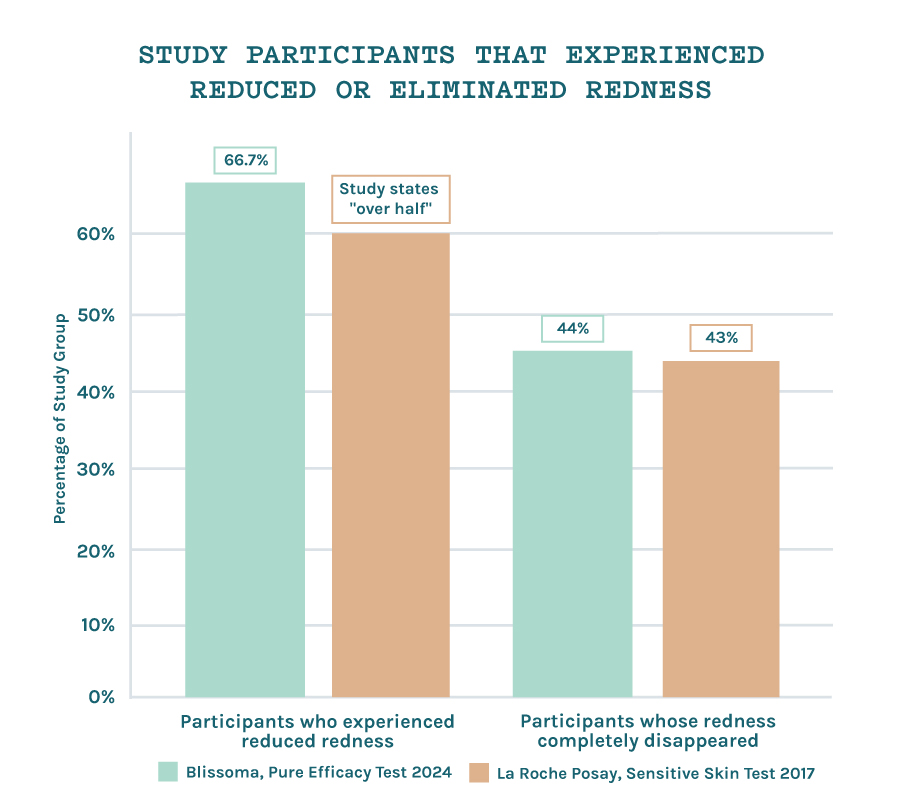
Another interesting finding in the La Roche Posay study on sensitive skin was how use of an effective, non prescription skincare product could affect the need for drug treatment of skin problems. For 52.6% of their participants, use of the La Roche Posay product eliminated the need for a drug. 33% of participants were able to reduce their drug dosage 33% and 21.1% were able to delay drug prescription.
Our clinical test results indicate that Pure Sensitive Care Complex can offer comparable or better results than this category-leading, clinically validated skincare brand.
Redness Reduction Comparison of Blissoma’s Pure with Physiogel Skincare and Vichy Mineral 89 Serum
A 2019 study was conducted on the Physiogel CR Anti-Redness Day Cream SPF 20 and Physiogel Calming Relief Anti-Redness Serum to determine their benefits for winter dry skin and redness. This is of particular interest since our clinical test of Pure Sensitive Care Complex was also performed in the most severe part of winter in Canada.
The Physiogel study found that their day cream reduced redness about 35.2%, and that their serum reduced redness about 29.17% by day 29.
Vichy’s Mineral 89 Hyaluronic Acid Serum study from 2023 included redness measurements in addition to skin barrier strength. They found that Vichy’s serum reduced skin redness by 5.9% at day 30.
Pure Sensitive Care Complex solidly outperformed both the Physiogel and Vichy skincare products for redness reduction.
Pure Sensitive Care Complex is a Clinically Proven Redness Reduction Cream that Performed Better in Testing than 4 Leading Skincare Brands
Our goal has always been to help people calm, clear, and love their skin effectively using only healthy, safe ingredients. Now we have the third party, objective proof that we are achieving our goals in big ways. Pure Sensitive Care Complex performed on par with, or better than products from Cetaphil, La Roche Posay, Vichy, Physiogel, and others.
We have always put the needs of skin first and foremost and our smart recipes and manufacturing processes show that in how the products work for you.
Our customers, of course, already knew how well our products worked, and have been the first to tell us about it. We are incredibly grateful for the people that have believed in us through our journey to grow a holistic, ethical, ecological and effective skincare brand. It is because of our devoted client base that we were able to invest in this study. Your skin success is truly ours! Many of our customers have been with us for over 10 years and some have even become friends.
Now we want to reach many, many more people to show them the difference that whole plant ingredients can make for their skin. So many people are still suffering with disrupted skin and each of them deserves peace, comfort, and to love what they see in the mirror each day.
Do you know someone that could use natural, safe, profound, clinically proven results like we offer?
Right now we're offering a special chance to try both the holistic skincare products used in our clinical test.
That way you can conduct your own test at home for the same length of time as in our study!
Click to visit our shopping page to purchase your Pure Sensitive Care Complex, and get a FREE mini gel cleanser worth $30 so you can start your holistic skincare routine today.
And send this page to anyone that says you need to use synthetic skincare to get results!
Blissoma is proof that you can use gentle, supportive, nutritious, natural, and organic skincare to get great results for your skin.


